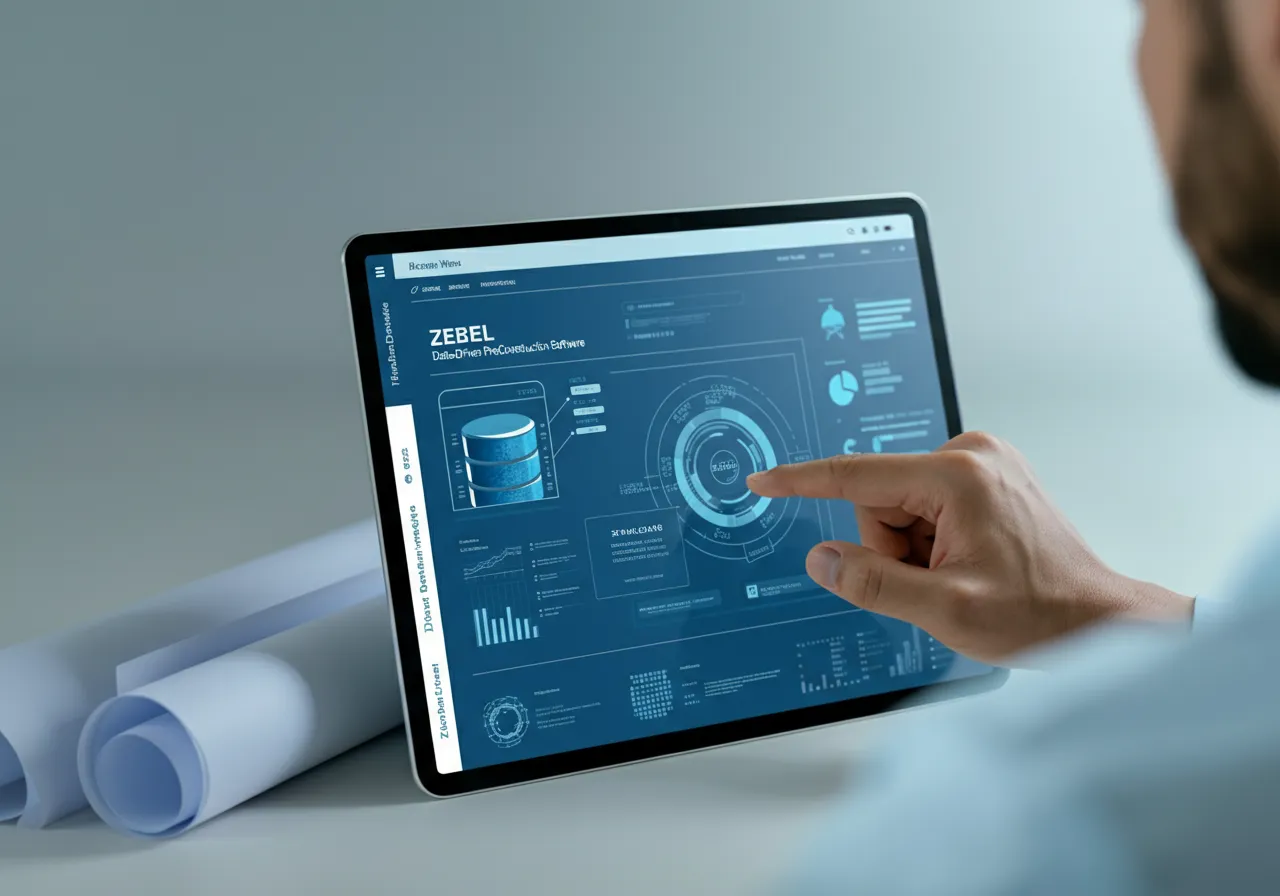Table of Contents
At the earliest stages of a project, when detailed plans and designs are unavailable, conceptual estimating provides the insights project owners and teams need to make informed decisions.
This early-phase estimate is more than just a number; it’s a strategic tool that evaluates feasibility, defines scopes, and guides preliminary planning.
This blog dives into conceptual estimating, its importance in construction, the factors affecting accuracy, the methods used, and how Zebel’s preconstruction software empowers teams to elevate their estimating process.
What is Conceptual Estimating?
Conceptual estimating, sometimes referred to as a “preliminary estimate,” is a process of evaluating project costs during the earliest phases, often when little detailed information is available. It relies on a combination of limited specifications, historical data, and professional judgment to project the potential costs of a project.
When is a Conceptual Estimate Used?
Typically, conceptual estimates are prepared during the conceptual phase of a project, long before detailed drawings or specifications are available. During this stage, decisions about project feasibility, budget constraints, and funding strategies are made.
Key Features of Conceptual Estimates:
- Based on Limited Information: Unlike detailed estimates, conceptual estimates use broad parameters like square footage, building type, or project location.
- Heavily Reliant on Historical Data: Comparisons to similar projects play a critical role in deciding costs.
- Preliminary in Nature: These estimates serve as starting points for feasibility studies, discussions with stakeholders, and budgeting frameworks.
What is the Result of a Conceptual Cost Estimate?
The result of a conceptual estimate is a clear and comprehensible representation of the anticipated costs associated with a project. This estimate provides detailed and extensive cost data, serving as a critical tool for planning and budgeting.
When utilized effectively, it becomes a foundational resource for shaping construction strategies, enabling builders and clients to make informed decisions and allocate project budgets efficiently.
How is it Different From Detailed Estimates?
While conceptual estimates provide a high-level cost approximation when little is known, detailed estimates are developed during later stages of a project with extensive design inputs, material lists, and construction methodologies. The accuracy of detailed estimates tends to be much higher due to the granularity of available data.
Conceptual Estimation vs. Detailed Estimation
It’s important to distinguish between cost estimation and conceptual estimation. These two methodologies serve different purposes and occur at different stages in the project lifecycle.
Aspect | Conceptual Estimation | Detailed Estimation |
When It’s Used | Conceptual phase (early stages) | Detailed design and construction phases |
Data Availability | Limited; relies on historical and broad assumptions | Extensive; depends on detailed designs, labor rates, etc. |
Accuracy | Ballpark figures; may deviate | High precision; refined based on granular data |
Primary Goal | Assess feasibility and set budgets | Determine specific project costs and timelines |
While both approaches are crucial, conceptual estimating stands out as a key enabler of efficient project planning.
Why Conceptual Estimates in Construction Matter – Pros and Cons
When it comes to construction projects, accurate cost estimation is pivotal for successful project planning and execution. Conceptual estimating is vital in this process, providing a high-level overview of project costs and timelines before detailed designs are finalized. However, there are both pros and cons to using conceptual estimating in construction projects.
Pros
Improved Decision-Making
Project stakeholders rely on conceptual estimates to make critical go/no-go decisions. By understanding the preliminary cost implications, developers and contractors can assess whether a project aligns with financial and operational goals.
Project Feasibility Analysis
Conceptual estimates help determine whether a project is financially viable. With insights into potential costs, teams can identify funding requirements and evaluate ROI.
Better Budgeting Strategies
A conceptual estimate sets the stage for realistic project budgets. It provides the foundation for allocating resources and managing financial constraints.
Risk Mitigation at Early Stages
By highlighting possible cost drivers, such as material price fluctuations or labor shortages, a conceptual estimate allows teams to forecast risks and develop contingencies to avoid overruns.
Cons
Limited Accuracy
One of the primary disadvantages of conceptual estimating is its inherent lack of precision. Since these estimates are often based on incomplete or preliminary project information, they can deviate significantly from actual costs. This margin of error may lead to incorrect assumptions or planning inefficiencies as the project progresses.
Reliance on Assumptions
Conceptual estimates are heavily reliant on assumptions and generalized data, making them vulnerable to inaccuracies if the initial inputs are flawed. Variations in scope, unforeseen conditions, or changes in requirements can quickly render an estimate outdated or irrelevant.
Potential for Overconfidence
An early estimate may instill undue confidence in stakeholders, leading to key decisions being made prematurely. This can result in challenges later if the actual costs diverge from initial projections, potentially derailing timelines or budgets.
Resource Intensive
Developing a conceptual estimate can be a time-consuming process requiring expertise, data analytics, and historical cost records. For smaller projects or organizations with limited resources, the effort required may outweigh the benefits if the estimate does not directly lead to actionable insights.
Key Factors Influencing Conceptual Estimates
To produce an accurate estimate, multiple elements must be considered:
- Project Scope: A clearly defined scope of work leads to better estimates. Ambiguities in design or function can lead to inaccurate budgets.
- Historical Data: The accuracy of a conceptual estimate leans heavily on data from past projects. Comprehensive project data containing costs, timelines, and scope ensures better predictability.
- Material Costs: Supply chain issues or volatile material costs impact estimates significantly. For example, steel and concrete price trends often cause budget variances.
- Labor Rates: Accurate forecasts of labor costs, including availability and regional wage rates, play a major role. Skilled labor shortages in certain areas can drive up project budgets.
- Location: Geographical factors—including zoning requirements, transportation logistics, and local market conditions—influence the total project cost substantially.
Methods of Conceptual Estimating
The conceptual estimating process uses several methodologies, each suited for different circumstances:
1. Square Foot Method
Using an average cost per square foot based on building type and location, this method provides quick assessments suitable for feasibility studies.
2. Parametric Estimating
This technique uses statistical models and historical data to calculate costs based on parameters like square footage, building stories, and materials used.
3. Analogous Estimating
Analogous estimating utilizes comparisons with similar, previous projects to generate fast estimations for new projects that lack extensive data.
4. Rough Order of Magnitude (ROM)
The ROM estimate gives an initial cost range (e.g., ±5-10% accuracy) when only conceptual information is available. This method is often a builder’s first pass at projecting project feasibility.
Common Challenges in Conceptual Estimating
Conceptual estimating is not without its hurdles. Some common challenges include:
Limited Data Availability
Conceptual estimates are often prepared during the early stages of a project, where detailed information about design, scope, and requirements may be sparse or unavailable. This lack of detailed data can lead to assumptions that might affect the accuracy and reliability of the estimate.
Scope Ambiguity
At the conceptual phase, the project scope is frequently not fully defined or documented. This ambiguity can result in misunderstandings or misinterpretations, leading to cost overruns or delays when the actual scope becomes clearer later in the project lifecycle.
Market Volatility
Fluctuations in market prices for materials, labor, and other resources can introduce unpredictability into cost estimations. Without firm market data, estimators may struggle to account for these variations, reducing the estimate’s precision.
Subjectivity in Assumptions
Conceptual estimations often rely on the expertise and judgment of the estimator to fill in gaps due to incomplete information. This subjectivity can lead to biases, especially if the estimator has limited experience or knowledge about similar projects.
External Variables and Uncertainties
Factors such as regulatory changes, environmental considerations, or unforeseen site conditions may not be adequately reflected in early estimates. These external variables can significantly alter project costs and timelines once they surface.
Pressure for Speed and Cost Accuracy
Stakeholders often expect fast turnaround times for conceptual estimates while also demanding a high degree of accuracy. Balancing these conflicting priorities can be challenging, particularly when time constraints limit the ability to conduct deeper analysis.
Communication Gaps
Ineffective communication between project teams, clients, and stakeholders during the early stages can lead to misinformation or misaligned expectations. This lack of clarity can adversely impact the estimating process and subsequent decision-making.
How to Create a Conceptual Estimate
A conceptual estimate is a rough estimate used in the early stages of a project, typically before detailed plans and specifications are available. It serves as an initial budget for planning purposes and can help determine whether or not a project is feasible.
Here’s how to create a conceptual estimate:
1. Gather Information
Start by gathering as much information as possible about the project, including any drawings, sketches, or preliminary designs. This will give you a general understanding of what needs to be built and how it will function.
2. Determine Scope
Next, break down the project into smaller components or tasks and determine the scope of work for each. This will help you identify potential costs and resources needed for each aspect of the project.
3. Research Costs
Now, it’s time to research the costs associated with each task or component. This may involve reaching out to vendors or suppliers for quotes, researching market prices for materials and labor, and factoring in any overhead costs.
4. Factor in Contingencies
It’s important to account for unexpected occurrences or changes that may arise during the project. Be sure to include a contingency percentage in your estimate to cover these potential expenses.
5. Use Estimating Tools
There are many construction estimating software tools available that can assist in creating conceptual estimates. These tools allow you to input all relevant information and generate an accurate estimate quickly and efficiently.
6. Collaborate with Team Members
Don’t hesitate to collaborate with your team members, such as architects, engineers, or project managers, when creating a conceptual estimate. They can provide valuable insights and help ensure all aspects of the project are accounted for in the estimate.
7. Continuously Update and Review
As the project progresses, it’s important to continuously update and review your conceptual estimate to ensure its accuracy. This will allow you to make any necessary adjustments in a timely manner and avoid any discrepancies later on.
Best Practices for Conceptual Estimating
When it comes to conceptual estimating, following best practices can significantly enhance the accuracy, reliability, and efficiency of your estimates. Below, we outline essential best practices to guide you through the conceptual estimating process.
1. Define Clear Project Objectives
Before beginning a conceptual estimate, ensure the project’s objectives are clearly defined. This involves understanding the scope, desired outcomes, major deliverables, and success criteria. A well-defined objective provides a roadmap for estimating costs effectively and minimizes the potential for scope changes during the project.
2. Leverage Historical Data
Historical data is an invaluable resource for accurate conceptual estimating. Examine past projects that are similar in size, complexity, and scope to provide baseline benchmarks. This data can inform cost trends, labor requirements, material prices, and other critical factors. It is important to validate that the data reflects current market conditions to avoid misalignment.
3. Collaborate With Stakeholders
Collaboration with key stakeholders—including clients, design teams, and contractors—is crucial for achieving a well-rounded estimate. These individuals bring unique insights and expertise that can highlight potential challenges or opportunities. Early collaboration ensures that all parties align on the project vision and cost expectations.
4. Identify Risks and Uncertainties
Effective conceptual estimates account for risks and uncertainties that may arise over the course of the project. Perform a risk assessment to identify factors such as market volatility, labor shortages, and potential regulatory changes. Incorporating contingency allowances into the estimate can safeguard against unexpected costs and schedule impacts.
5. Use Suitable Estimating Tools and Techniques
Employ modern estimating tools and methodologies that align with the project’s scope and complexity. Tools like cost databases, estimation software, and parametric models provide efficient and accurate calculations. Selecting the right methodology—such as square footage pricing or unit cost estimating—ensures the estimate matches project requirements.
6. Maintain Flexibility and Adaptability
Conceptual estimating must remain flexible to accommodate design evolutions and client feedback. Regularly revisiting the estimate as project details are refined allows for adjustments that reflect updated information. Maintaining adaptability ensures that the estimate remains a reliable planning tool throughout development.
7. Document Assumptions and Limitations
Clearly document all assumptions and limitations used during the development of the conceptual estimate. Transparency around factors such as material specifications, pricing levels, and labor rates avoids future misinterpretations. This practice also supports accountability and ensures all stakeholders understand the basis of the estimate.
8. Use Technology to Your Advantage
Leveraging technology can greatly enhance the accuracy and efficiency of conceptual estimating. Project management software, cost estimation tools, and virtual modeling programs can aid in creating more detailed estimates and visualizations.
Additionally, these technologies can also track project progress and provide real-time cost updates. Incorporating technology into the conceptual estimating process allows teams to save time, reduce errors, and improve overall project outcomes.
How Zebel Empowers Conceptual Estimating
Zebel is revolutionizing the construction industry by combining powerful data analytics and user-friendly estimating tools designed for professionals.
“Napkins to Numbers” Approach
Zebel streamlines the estimating process, consolidating data for accuracy and efficiency—even if all you have is a basic napkin sketch.
Comprehensive Historical Database
With Zebel, users can build their own cost libraries and access comparative market data from other customers to fine-tune estimates.
Quick, Accurate Estimates
Zebel generates cost estimates in minutes by analyzing project parameters and matching them with historical data points.
Integration and Collaboration
From conceptual cost estimating to detailed designs, Zebel seamlessly integrates into your workflow, enabling you to manage project data and collaborate effectively across teams.
Elevate Your Estimating Game with Zebel
Conceptual estimating paves the way for successful construction projects. By focusing on feasibility, accuracy, and collaboration, teams can set their projects up for success from day one.
Zebel takes the complexity out of cost estimating, empowering preconstruction professionals to predict and deliver better outcomes with unparalleled efficiency.
Don’t rely on spreadsheets to guide your critical decisions. Explore the Zebel platform today to redefine your estimating and project management processes.
Frequently Asked Questions
What are the four types of estimates in construction?
The four types of estimates in construction are preliminary, detailed, quantity-based, and bid estimates. Each serves a specific purpose, from early project budgeting to finalizing precise costs for bids.
What type of estimate is the most accurate?
The most accurate type of estimate is the detailed estimate, as it involves a comprehensive analysis of materials, labor, equipment, and other factors based on finalized project specifications and designs. This ensures precise cost forecasting and minimizes the risk of unforeseen expenses.
How accurate is a conceptual estimate?
A conceptual estimate typically has an accuracy range of ±5% to ±10%, depending on the quality and availability of early project information. It is used for initial planning and feasibility assessments rather than precise budgeting.







